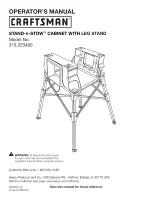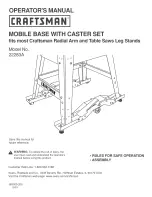
23 ENGLISH
Vertical vise
WARNING:
The workpiece must be secured
firmly against the turn base and guide fence with
the vise during all operations.
If the workpiece is
not properly secured against the fence the material
may move during the cutting operation causing
possible damage to the blade, causing the material
to be thrown and loss of control resulting in serious
personal injury.
►
Fig.41:
1.
Vise arm
2.
Vise rod
3.
Clamping screw
4.
Vise knob
The vertical vise can be installed in two positions on
either the left or right side of the base. Insert the vise
rod into the hole in the base.
Position the vise arm according to the thickness and
shape of the workpiece and secure the vise arm by
tightening the screw. If the clamping screw contacts
the carriage, install it on the opposite side of vise arm.
Make sure that no part of the tool contacts the vise
when lowering the handle all the way. If some part
contacts the vise, re-position the vise.
Press the workpiece flat against the guide fence and the
turn base. Position the workpiece at the desired cutting
position and secure it firmly by tightening the vise knob.
NOTE:
For a quick setting of workpiece, turning the
vise knob to 90° counterclockwise allows the vise
knob to be moved up and down. To secure the work-
piece after setting, turn the vise knob clockwise.
Horizontal vise
Optional accessory
WARNING:
Always rotate the vise nut clock
-
wise until the workpiece is properly secured.
If the
workpiece is not properly secured, the material may
move during the cutting operation causing possible
damage to the saw blade, causing the material to be
thrown and loss of control resulting in serious per-
sonal injury.
WARNING:
When cutting a thin workpiece,
such as base boards, against the fence, always
use the horizontal vise.
CAUTION:
When cutting the workpiece of the
thickness 20 mm or thinner, make sure to use a
spacer block to secure the workpiece.
The horizontal vise can be installed in two positions on
either the left or right side of the base. When performing
22.5° or greater miter cuts, install the horizontal vise on
the side opposite the direction in which the turn base is
to be turned.
►
Fig.42:
1.
Vise plate
2.
Vise nut
3.
Vise knob
By flipping the vise nut counterclockwise, the vise is
released, and rapidly moves in and out. To grip the
workpiece, push the vise knob forward until the vise
plate contacts the workpiece and flip the vise nut clock
-
wise. Then turn the vise knob clockwise to secure the
workpiece.
NOTE:
The maximum width of workpiece which can
be secured by the horizontal vise is 228 mm.
Holders
WARNING:
Always support a long workpiece
so it is level with the top surface of the turn base
for an accurate cut and to prevent dangerous loss
of tool control.
Proper workpiece support will help
avoid blade pinch and possible kickback which may
result in serious personal injury.
To hold long workpieces horizontally, holders are pro-
vided on both sides of the tool. Loosen the screws and
extend the holders to the appropriate length for holding
the workpiece. Then tighten the screws.
►
Fig.43:
1.
Holder
2.
Screw
OPERATION
This tool is intended to cut wood products. With appro-
priate Makita genuine saw blades, following materials
can also be sawed :
— Aluminum products
Refer to our website or contact your local Makita dealer
for the correct circular saw blades to be used for the
material to be cut.
WARNING:
Make sure the saw blade is not con-
tacting the workpiece, etc. before the switch is turned
on.
Turning the tool on with the blade in contact with the
workpiece may result in kickback and serious personal injury.
WARNING:
After a cutting operation, do not
raise the saw blade until it has come to a complete
stop.
The raising of a coasting blade may result in seri-
ous personal injury and damage to the workpiece.
WARNING:
Do not perform any adjustment
such as turning grip, knob, and levers on the tool
while the saw blade is rotating.
Adjustment while the
blade is rotating may result in serious personal injury.
CAUTION:
Do not release the saw head
uncontrolled from the fully down position.
Uncontrolled saw head may hit you and it will result in
personal injury.
NOTICE:
Before use, be sure to unlock the stopper
pin and release the handle from the lowered position.
NOTICE:
Do not apply excessive pressure on the
handle when cutting.
Too much force may result in
overload of the motor and/or decreased cutting effi
-
ciency. Press down handle with only as much force as
necessary for smooth cutting and without significant
decrease in blade speed.
NOTICE:
Gently press down the handle to per
-
form the cut.
If the handle is pressed down with force
or if lateral force is applied, the blade may vibrate and
leave a mark (saw mark) in the workpiece and the
precision of the cut may be impaired.
NOTICE:
During a slide cut, gently push the
carriage toward the guide fence without stopping.
If the carriage movement is stopped during the cut, a
mark will be left in the workpiece and the precision of
the cut will be impaired.
Summary of Contents for LS1019
Page 2: ...2 Fig 1 10 11 12 14 15 3 2 4 5 8 7 9 13 6 1 16 17 18 19 20 21 Fig 2 ...
Page 3: ...3 7 8 5 6 1 2 3 4 9 10 11 14 13 12 15 Fig 3 1 2 Fig 4 1 2 3 4 4 Fig 5 ...
Page 4: ...4 2 1 Fig 6 3 1 2 Fig 7 1 Fig 8 1 Fig 9 3 1 2 Fig 10 1 Fig 11 ...
Page 5: ...5 1 2 3 4 6 5 Fig 12 1 Fig 13 1 Fig 14 1 2 3 Fig 15 1 2 Fig 16 ...
Page 6: ...6 1 2 3 4 Fig 17 1 Fig 18 1 Fig 19 1 2 Fig 20 1 Fig 21 1 Fig 22 ...
Page 7: ...7 1 Fig 23 3 1 2 Fig 24 1 2 3 Fig 25 1 Fig 26 1 Fig 27 A B Fig 28 1 Fig 29 ...
Page 8: ...8 1 2 3 Fig 30 3 1 2 Fig 31 1 2 4 4 5 5 3 Fig 32 1 2 Fig 33 1 2 3 4 5 6 Fig 34 ...
Page 9: ...9 1 2 3 Fig 35 1 2 Fig 36 1 Fig 37 1 2 Fig 38 1 2 3 1 2 3 4 4 Fig 39 1 2 3 Fig 40 ...
Page 10: ...10 1 2 3 4 Fig 41 1 2 3 Fig 42 1 2 Fig 43 1 Fig 44 1 Fig 45 ...
Page 12: ...12 1 Fig 53 Fig 54 2 1 2 3 Fig 55 1 Fig 56 1 2 Fig 57 1 2 3 Fig 58 Fig 59 ...
Page 13: ...13 1 2 Fig 60 1 2 3 4 5 Fig 61 1 2 3 4 5 Fig 62 1 2 Fig 63 1 Fig 64 ...
Page 14: ...14 1 Fig 65 ...
Page 179: ...179 ...
















































